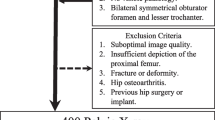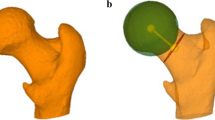Abstract
Purpose
To propose a novel method for measuring the femoral neck torsion angle (FNTA) with femoral neck oblique axial computed tomography (CT) reconstruction.
Methods
Fifty-five patients (24 females, 31 males; mean age 48.8 years [range, 20–91 years]) were included in the study. CT scans were performed on the left femurs of 27 patients and the right femurs of the remaining 28 patients. The images were analyzed independently by two observers using oblique axial femoral neck CT reconstruction. Intra-observer and inter-observer agreement was calculated as intraclass correlation coefficient (ICC).
Results
FNTA can be measured with high intra-observer (ICC = 0.961) and high inter-observer (ICC = 0.982) agreement. Mean FNTA was slightly larger in women than in men, and the mean left FNTA was slightly larger than the right, but neither difference was statistically significant.
Conclusions
Femoral neck oblique axial CT reconstruction can be used to obtain accurate measurement of FNTA with good reproducibility. No significant differences were found in FNTA between sexes or sides.






Similar content being viewed by others
References
Mesgarzadeh M, Revesz G, Bonakdarpour A (1987) Femoral neck torsion angle measurement by computed tomography. J Comput Assist Tomogr 11(5):799–803
Jia J, Li L, Zhang L, Zhao Q, Liu X (2012) Three dimensional-CT evaluation of femoral neck anteversion, acetabular anteversion and combined anteversion in unilateral DDH in an early walking age group. Int Orthop 36(1):119–124
Teo PC, Kassim AY, Thevarajan K (2013) A 45-degree radiographic method for measuring the neck shaft angle and anteversion of the femur: a pilot study. J Orthop Surg 21(3):340–346
Ogata K, Goldsand EM (1979) A simple biplanar method of measuring femoral anteversion and neck-shaft angle. J Bone Joint Surg Am 61(6A):846–851
Lee DY, Lee CK, Cho TJ (1992) A new method for measurement of femoral anteversion. A comparative study with other radiographic methods. Int Orthop 16(3):277–281
Dunn DM (1952) Anteversion of the neck of the femur; a method of measurement. J Bone Joint Surg (Br) 34-B(2):181–186
Haspl M, Bilic R (1996) Assessment of femoral neck-shaft and antetorsion angles. Int Orthop 20(6):363–366
Moulton A, Upadhyay SS (1982) A direct method of measuring femoral anteversion using ultrasound. J Bone Joint Surg (Br) 64(4):469–472
Tomczak RJ, Guenther KP, Rieber A, Mergo P, Ros PR, Brambs HJ (1997) MR imaging measurement of the femoral antetorsional angle as a new technique: comparison with CT in children and adults. AJR Am J Roentgenol 168(3):791–794
Sugano N, Noble PC, Kamaric E (1998) A comparison of alternative methods of measuring femoral anteversion. J Comput Assist Tomogr 22(4):610–614
Hernandez RJ, Tachdjian MO, Poznanski AK, Dias LS (1981) CT determination of femoral torsion. AJR Am J Roentgenol 137(1):97–101
Weiner DS, Cook AJ, Hoyt WA Jr, Oravec CE (1978) Computed tomography in the measurement of femoral anteversion. Orthopedics 1(4):299–306
Reikeras O, Bjerkreim I, Kolbenstvedt A (1983) Anteversion of the acetabulum and femoral neck in normals and in patients with osteoarthritis of the hip. Acta Orthop Scand 54(1):18–23
Fleiss JL (2011) Design and analysis of clinical experiments. Wiley, Hoboken
Schneider B, Laubenberger J, Jemlich S, Groene K, Weber HM, Langer M (1997) Measurement of femoral antetorsion and tibial torsion by magnetic resonance imaging. Br J Radiol 70(834):575–579
Gulan G, Matovinovic D, Nemec B, Rubinic D, Ravlic-Gulan J (2000) Femoral neck anteversion: values, development, measurement, common problems. Coll Antropol 24(2):521–527
Conflict of interest
The authors declare that they have no conflicts of interest.
Author information
Authors and Affiliations
Corresponding author
Rights and permissions
About this article
Cite this article
Yin, Y., Zhang, L., Hou, Z. et al. Measuring femoral neck torsion angle using femoral neck oblique axial computed tomography reconstruction. International Orthopaedics (SICOT) 40, 371–376 (2016). https://doi.org/10.1007/s00264-015-2922-4
Received:
Accepted:
Published:
Issue Date:
DOI: https://doi.org/10.1007/s00264-015-2922-4




